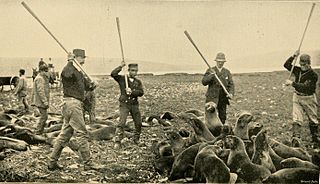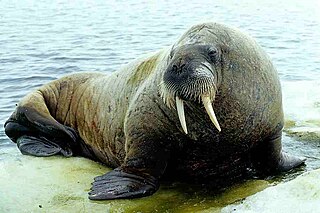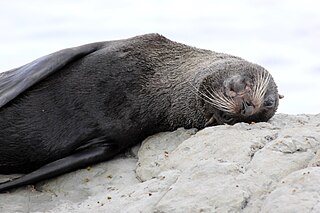 W
WPinnipedia is an infraorder of mammals in the order Carnivora, composed of seals, sea lions, and the walrus. A member of this group is called a pinniped or a seal. They are widespread throughout the ocean and some larger lakes, primarily in colder waters. Pinnipeds range in size from the 1 m and 45 kg (99 lb) Baikal seal to the 5 m (16 ft) and 3,200 kg (7,100 lb) male southern elephant seal, which is also the largest member of the order Carnivora. Several species exhibit sexual dimorphism. Most species do not have population estimates, though seven are classified as endangered with population counts as low as 300, and two, the Caribbean monk seal and the Japanese sea lion, went extinct in the 20th century.
 W
WPinnipeds, commonly known as seals, are a widely distributed and diverse clade of carnivorous, fin-footed, semiaquatic marine mammals. They comprise the extant families Odobenidae, Otariidae, and Phocidae. There are 33 extant species of pinnipeds, and more than 50 extinct species have been described from fossils. While seals were historically thought to have descended from two ancestral lines, molecular evidence supports them as a monophyletic lineage. Pinnipeds belong to the order Carnivora and their closest living relatives are bears and the superfamily of musteloids, having diverged about 50 million years ago.
 W
WSeal hunting, or sealing, is the personal or commercial hunting of seals. Seal hunting is currently practiced in ten countries: United States, Canada, Namibia, Denmark, Iceland, Norway, Russia, Finland and Sweden. Most of the world's seal hunting takes place in Canada and Greenland.
 W
WSeal meat is the flesh, including the blubber and organs, of seals used as food for humans or other animals. It is prepared in numerous ways, often being hung and dried before consumption. Historically, it has been eaten in many parts of the world, both as a part of a normal diet, and as sustenance.
 W
WAn eared seal or otariid or otary is any member of the marine mammal family Otariidae, one of three groupings of pinnipeds. They comprise 15 extant species in seven genera and are commonly known either as sea lions or fur seals, distinct from true seals (phocids) and the walrus (odobenids). Otariids are adapted to a semiaquatic lifestyle, feeding and migrating in the water, but breeding and resting on land or ice. They reside in subpolar, temperate, and equatorial waters throughout the Pacific and Southern Oceans and the southern Indian and Atlantic Oceans. They are conspicuously absent in the north Atlantic.
 W
WThe earless seals, phocids or true seals are one of the three main groups of mammals within the seal lineage, Pinnipedia. All true seals are members of the family Phocidae. They are sometimes called crawling seals to distinguish them from the fur seals and sea lions of the family Otariidae. Seals live in the oceans of both hemispheres and, with the exception of the more tropical monk seals, are mostly confined to polar, subpolar, and temperate climates. The Baikal seal is the only species of exclusively freshwater seal.
 W
WFur seals are any of nine species of pinnipeds belonging to the subfamily Arctocephalinae in the family Otariidae. They are much more closely related to sea lions than true seals, and share with them external ears (pinnae), relatively long and muscular foreflippers, and the ability to walk on all fours. They are marked by their dense underfur, which made them a long-time object of commercial hunting. Eight species belong to the genus Arctocephalus and are found primarily in the Southern Hemisphere, while a ninth species also sometimes called fur seal, the northern fur seal, belongs to a different genus and inhabits the North Pacific.
 W
WGuardians of the Gate is a 1991 Everdur bronze sculpture depicting a family of sea lions by Miles Metzger, located northwest of Pier 39 and adjacent to the Embarcadero Center in San Francisco, California, United States. The sculpture was dedicated on January 22, 1992 and was surveyed by the Smithsonian Institution's Save Outdoor Sculpture! program the same year. It is administered by Pier 39 Limited Partnership Beach Street and the Embarcadero Center.
 W
WHauling-out is a behaviour associated with pinnipeds temporarily leaving the water. Hauling-out typically occurs between periods of foraging activity. Rather than remain in the water, pinnipeds haul-out onto land or sea-ice for reasons such as reproduction and rest. Hauling-out is necessary in seals for mating and giving birth. Other benefits of hauling-out may include predator avoidance, thermoregulation, social activity, parasite reduction and rest.
 W
WMonachinae is a subfamily of Phocidae whose distribution is found in the tropical, temperate and polar regions of the southern hemisphere, though in the distant past fossil representatives have been found on both sides of the North Atlantic Ocean. The difference between members of this group and members of Phocinae is in monachines the hindclaws are greatly reduced in size. Furthermore, all species have 34 chromosomes. There are three tribes recognized here: Monachini, Miroungini, and Lobodontini. While today represented by eight extant and one recently extinct species, Monachinae had an incredibly enriched fossil diversity that went into decline soon to be replaced by southern species of sea lions and fur seals.
 W
WOdobenidae is a family of pinnipeds. The only living species is the walrus. In the past, however, the group was much more diverse, and includes more than a dozen fossil genera.
 W
WOtarioidea is a superfamily of pinnipeds that includes the families Desmatophocidae, Odobenidae, Otariidae and their stem-relatives. In the past when the pinnipeds were considered to be a diphyletic group of marine mammals, based on the few cranial and dental morphology that the otarioids originated from a line of bears. One extinct family, Enaliarctidae, was postulated to be otarioids that were a transitional clade between Hemicyoninae and Otariidae. Recent comprehensive studies have, however, since the 1990s found pinnipeds to be a monophyletic clade of aquatic arctoids. There are a few authorities that place desmatophocids and odobenids as sister taxa to Phocidae in the clade Phocomorpha based on a few minor physiological features.
 W
WPARO is a therapeutic robot baby harp seal, intended to be very cute and to have a calming effect on and elicit emotional responses in patients of hospitals and nursing homes, similar to animal-assisted therapy except using robots.
 W
WPhocinae is a subfamily of Phocidae whose distribution is found in the seas surrounding the Holarctic, with the Baikal seal being the world's only freshwater species of pinniped. What distinguishes them from other phocid seals is the presence of well-developed claws on their front and back flippers. The Phocinae is divided into three extant tribes: Erignathini, Cystophorini, and Phocini. Members of both Erignathini and Cystophorini have 34 chromosomes, while species in the tribe Phocini have 32 chromosomes.
 W
WSeal culling in South Australia was strongly advocated for in 2015 in response to increasing interactions of Arctocephalus forsteri, the indigenous long-nosed fur seal, with the state's fishing industry. In the 19th century, both fur seals and Australian sea lions were hunted for their hides. During the 20th century, seals were sometimes culled on the assumption that they were competing with fishermen. As of 2018 seal culling is illegal, but remains a topic of public debate. All pinnipeds in South Australia remain fully protected under the National Parks and Wildlife Act 1972 as listed Marine Mammals. As of 2016, there were an estimated 100,000 long-nosed fur seals in South Australian waters.
 W
WSeal Island is a 1948 American documentary film directed by James Algar. Produced by Walt Disney, it was the first installment of the True-Life Adventures series of nature documentaries. It won an Oscar in 1949 for Best Short Subject (Two-Reel).
 W
WSealskin is the skin of a seal.
 W
WThe Seal Rehabilitation and Research Centre is located in Pieterburen, Netherlands.